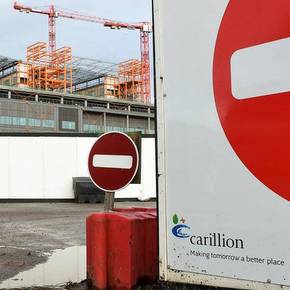
How building suppliers should react to the Carillion crisis
 Paul Black, CEO at sales-i, has analysed three important questions that building suppliers affected by the collapse of Carillion should ask.
Paul Black, CEO at sales-i, has analysed three important questions that building suppliers affected by the collapse of Carillion should ask.
The Carillon collapse has had – and will continue to have – a huge impact on the building and construction supply chain. For 30,000 suppliers and builders’ merchants, Carillon represented a hugely important and lucrative client. Without this big account on their books, they could stand to lose a significant chunk of turnover. What’s more, some of these companies don’t have insurance in place to cover such an event. As the impact of the situation continues to ripple through the sector, many businesses are developing a negative outlook on the future.
This need not be the case. Businesses affected by the loss of Carillon can put a plan in place now to recover. While suppliers can’t be blamed for the crisis, they can choose how to respond to it. Losing a big client is without a doubt unsettling and challenging, as it would be for any industry. However, it also represents an opportunity for any business to re-evaluate its customer relationship strategy.
If your business has been affected by the collapse of Carillon or not, here are three critical questions to ask.
1. Is enough effort being put into customer retention, as well as acquisition?
Carillion represented a long-term client for many businesses. Suppliers benefitted significantly from having this valuable account on retainer. All too often, seeing to the needs of the biggest client can result in the supplier underservicing its other clients, or pushing new business opportunities to the bottom of the priority list. You always need to think about other customers – those you already have, and then those you want to have.
As we’ll soon see, those suppliers that paid attention to customer loyalty and retention will likely ride out the impact of the Carillion collapse better than those that did not. It’s incredibly risky to have all your eggs in one basket. Suppliers and builders’ merchants must constantly balance acquisition with retention to mitigate the risks of customer churn – and build a roster of loyal, satisfied customers to help weather crises.
2. Are you missing out on important opportunities due to a lack of visibility?
Another important question to ask is: are you getting the most value out of your existing customers? Spending within the construction industry can fluctuate significantly. No matter how loyal your customers are, you can’t just sit back and expect new orders and job requests to simply roll in. You need to take a proactive approach to identifying new business opportunities.
Chances are, your business (like many industry suppliers) is sitting on a lot of customer data – and not putting it to very effective use. It’s time to take full advantage of all this disconnected and fragmented information. By harnessing this data, you will be able to unearth buying trends that aren’t immediately visible – but are potentially incredibly lucrative.
A clear view of these patterns can help you ‘predict’ when important opportunities will emerge and enables you to pre-empt customer need. It also allows you to optimise features like product bundling and pricing with a stronger ability to anticipate demand.
3. Are your salespeople proactive and agile enough?
To build stronger customer relations and identify lucrative opportunities, you need empowered sales representatives who are proactive and agile. With data-driven insights supporting their
every move, they’ll be able to reach out and engage with customers and prospects. This will put them leaps ahead of rival suppliers – and represents a crucial head-start in an increasingly competitive environment.
Data can help sales teams unearth hidden opportunities in the market – and go after them armed with relevant information. It’s a powerful approach that results in many more successful sales. Of course, to stay agile and connected, salespeople must have access to the right IT and business software to support their efforts. In the fast-moving world of technology, it’s easy to feel overwhelmed by all the choice. However, relying on outdated software is inefficient and risky.
Bouncing back
Rather than simply waiting for needy customers to emerge, salespeople must access and act on data insights to address their customers’ needs in advance. In the wake of the Carillon collapse, all builders’ suppliers and merchants need to review their approach to customer retention and acquisition. Losing a big client can be a shock to the system, but with the right questions top of mind, and the right approach to sales, suppliers can bounce back quickly. Or even better, not feel the impact at all.
The collapse of Carillon has already raised many important questions and will very likely affect how companies in the building and construction supply chain do business going forward. Change is ever-present, and complacency is dangerous. It’s critical that suppliers take heed of current events and prepare their businesses as best as they can to withstand any uncertainty that lies ahead.
Latest news

26th July 2024
Enfield Speciality Doors completes world-class project for Atlas Copco HQ
A rundown office and warehouse building completely transformed into a modern headquarters for Atlas Copco has been fitted with more than 120 internal fire doors from Enfield Speciality Doors.
Posted in Access Control & Door Entry Systems, Articles, Building Industry News, Building Products & Structures, Building Systems, Case Studies, Doors, Interior Design & Construction, Interiors, Posts, Restoration & Refurbishment, Retrofit & Renovation, Security and Fire Protection, Sustainability & Energy Efficiency, Timber Buildings and Timber Products, Wooden products
26th July 2024
Abloy UK launches new white paper
Abloy UK, a leading provider of security and access control solutions, has launched a new white paper.
Posted in Access Control & Door Entry Systems, Architectural Ironmongery, Articles, Building Industry News, Building Products & Structures, Building Services, Doors, Facility Management & Building Services, Health & Safety, Information Technology, Innovations & New Products, Publications, Research & Materials Testing, Security and Fire Protection
26th July 2024
MCRMA Member Profile: David Roy, Director of Roofconsult
David Roy of MCRMA member company Roofconsult has more than 50 years’ experience to draw upon working in the building envelope sector and a unique perspective on how it has changed in that time.
Posted in Articles, BIM, Infrastructure & CAD Software, Building Associations & Institutes, Building Industry News, Building Products & Structures, Building Services, Building Systems, Cladding, Information Technology, Restoration & Refurbishment, Retrofit & Renovation, Roofs, Walls
26th July 2024
Strand: Enhancing Door Functionality and Safety
Craig Fox, Sales Director for Strand Hardware, outlines how door industry professionals might apply door limiting stays…
Posted in Architectural Ironmongery, Articles, Building Industry News, Building Products & Structures, Building Services, Doors, Facility Management & Building Services, Health & Safety, Restoration & Refurbishment, Retrofit & Renovation
 Sign up:
Sign up: